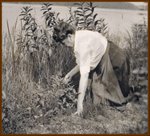The Cabin rang with music both days, thanks to Nancy Blough and friends. Mountain dulcimers, harps, bass, auto harp, piano, percussion instruments were played by talented musicians, but Nancy enjoys involving the guests so there was also dancing, singing and keeping time with spoons.
And another Nancy spent both days baking zucchini bread in the kitchen and the smell drew guests right into the kitchen.

I was asked to decorate the garden shed. First, though, I had to pack up the tender bulbs for winter, bag up the seeds collected and sweep out a ton of dirt. Lisa and Carol helped me do that on Thursday. Then on Friday my sister came up and we decorated the Garden Shed tree and mausoleum. Here is the tree decorated with flowers from the garden and bird's nests from the site. (It wasn't possible to stage a good shot because this is a working garden shed and our "stuff" cluttered the background.)
 The garden shed was used to make Christmas crafts. This year, Cheri (on the left with one of her helpers on the right) laid out nature items and boy were the guests creative!
The garden shed was used to make Christmas crafts. This year, Cheri (on the left with one of her helpers on the right) laid out nature items and boy were the guests creative!
















































